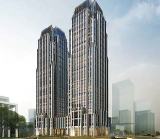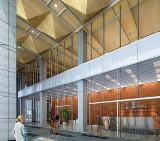Sustainable building planning



Foshan New City as a milestone
The rapid urbanization taking place in China is unprecedented in the history of mankind. According to a McKinsey forecast, an unimaginable 350 million people will move to Chinese cities over the next 15 years. Entire districts are being built from scratch and, for the first time since 2011, more than half of the Chinese people live in cities. The pressure on those concerned is enormous. The government has to build affordable housing for all these people as fast as possible and, at the same time, create the jobs that make the Chinese dream of a better life, a car or an apartment possible.
Competition for foreign and industrial investment is being witnessed among cities that, despite having several million inhabitants, stand in the shadow of megacities such as Beijing, Shanghai or Guangzhou. The Chinese economy is dependent on the real estate market, making innovations in the building sector a decisive growth factor.
During his visit to the Head Office of the Fraunhofer-Gesellschaft when he was then Secretary of the Gangdong Province Party Committee, today's Vice Premier Wang Yang was able to see for himself the decisive contribution the Fraunhofer-Gesellschaft institutes makes to an innovation-based economy. Christoph Mitterer from Fraunhofer IBP demonstrated this in his presentation taking pilot projects and product innovation cycles with the participation of the institute as examples. This visit laid the foundation for an agreement on strategic cooperation between the provincial government of Guangdong and Fraunhofer. The aim of this cooperation is to promote the economy through innovation, with a focus on sustainable building methods.
Thanks to their hard work in a challenging acquisition phase, Fraunhofer IBP was awarded an accompanying research contract worth one million euros by the Chinese urban development company “Foshan New City”. As a showcase project for sustainable building practices in the city of Foshan, two 185 meter-high office towers are being developed for the Sino-German Industrial Service Platform in strict compliance with budget constraints. From 2013 to 2016, scientists from the departments of Hygrothermics and Indoor Climate are providing assistance during all phases of the project, from the architectural competition and the planning process right up to commissioning the buildings and calculating their future energy requirements. They are validating and verifying the results from each planning phase. They are also evaluating the entire planning process with regard to result-oriented and integrated planning processes.
In addition, the Fraunhofer team will be developing references for sustainable building practices. The buildings will be designed in such a way that they can be certified according to the Chinese assessment system “Evaluation Standard for Green Buildings”. The concept of this system is similar to the Germany equivalent known as the “German Quality Seal for Sustainable Building”. For this reason, the researchers also want to compare the two systems directly in practice and implement individual criteria of the DGNB system. To realize the building project, a single Chinese general contractor has been commissioned who is responsible for investment, construction planning, procurement and construction work all from one source. What at first glance appears to be efficient is a particular challenge for the Fraunhofer researchers as far as continuous evaluation and validation of the planning results are concerned. This is because the decision-making processes are not exactly transparent and that the extremely cost-conscious interests of the general contractor are offset by the owner's desire for innovation. With such a project constellation, it has transpired that is highly important to define quality requirements in detail right from the start.
After the two-year construction phase, which is scheduled to start in mid-2014, a one-year control phase will evaluate whether the quality requirements have been met. An assessment will be also be made during this period to determine whether the building services technology needs to be modified in order to optimize operation of the building. The process documentation carried out as part of the accompanying research project guarantees systematic tracking and optimization of the planning process. The processes evaluated and summarized in a guide at the end of the project will ensure that the knowledge acquired through this project can be applied to future projects. As part of its collaboration with Foshan New City, Fraunhofer is not only gaining experience in decision-making and construction processes in China, but also finding out how quality control can be improved and innovations in the building sector can be driven forward. In addition, new opportunities are opening up for further projects of this kind to promote a continuous exchange of information between the two countries on sustainable building methods and product innovation.
Background: The severe air pollution in the cities is partly due to the huge amount of construction activity and the energy consumed to heat and cool buildings. Not only do minimum requirements for energy efficiency exist in China but also a rating system for sustainable buildings. Nevertheless, despite many buildings being called ”green” in China, they are often not sustainable. There are many reasons for this. Requirements from evaluation systems are often implemented without thinking and new solutions are chosen without sufficiently checking their impact on the entire building system. The usual planning practices and prescribed approval processes favor standard designs and hamper innovation. Unrealistic time schedules and inadequate planning processes result in quality losses.